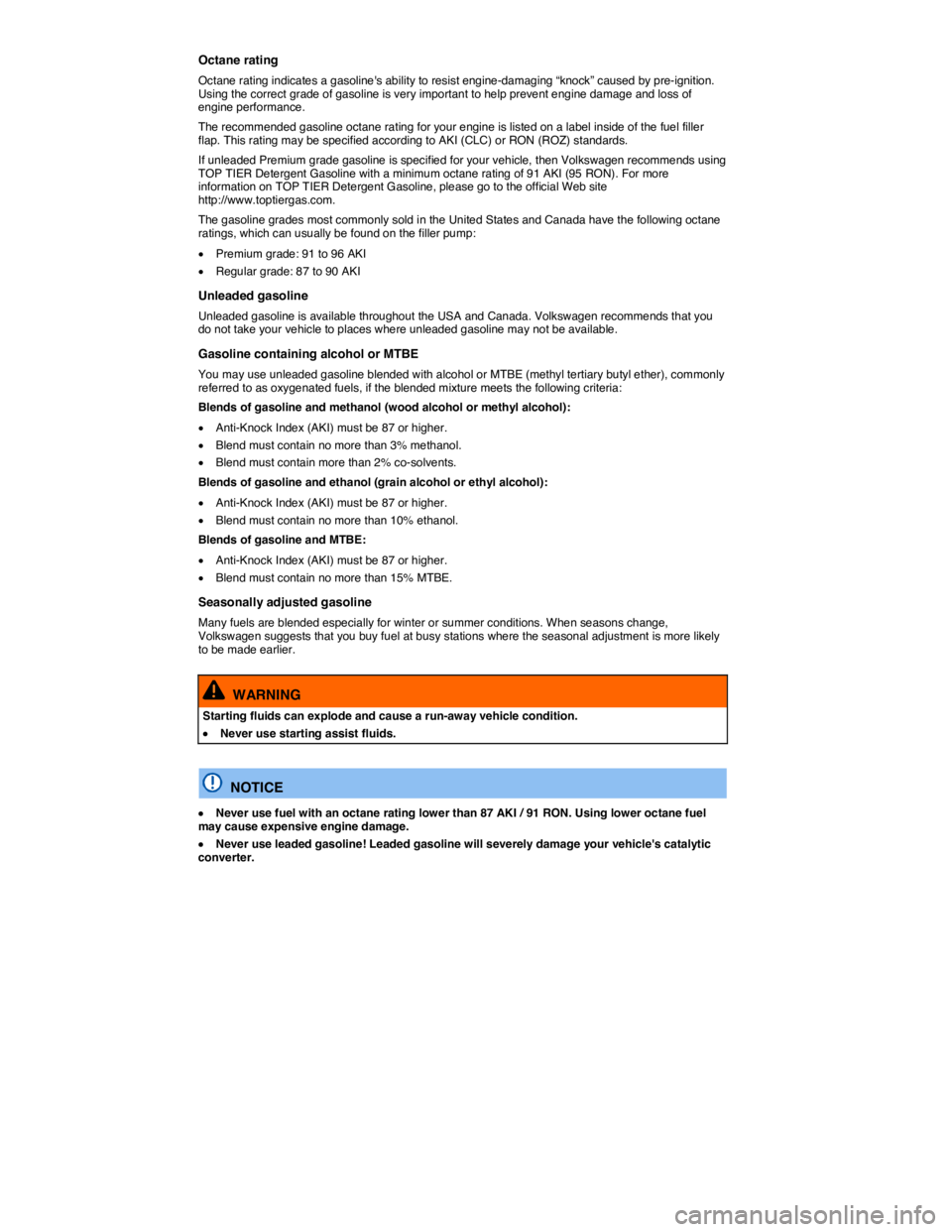2007 VOLKSWAGEN PASSAT Index
[x] Cancel search: IndexPage 167 of 392

If you have to mount a tire opposite to its proper direction of rotation, you must drive more carefully, since the tire is no longer being used as designed. This is particularly important on wet roads. You must replace or remount the tire as soon as possible in order to restore the correct direction of rotation.
Load rating code
The load index indicates the maximum permissible load per individual tire in pounds (kilograms).
91 1356 lbs (615 kg)
92 1388 lbs (630 kg)
93 1433 lbs (650 kg)
95 1521 lbs (690 kg)
97 1609 lbs (730 kg)
98 1653 lbs (750 kg)
99 1709 lbs (775 kg)
100 1763 lbs (800 kg)
101 1819 lbs (825 kg)
102 1874 lbs (850 kg)
103 1929 lbs (875 kg)
104 1984 lbs (900 kg)
110 2337 lbs (1060 kg)
Speed rating code letter
The speed rating code letter indicates the maximum permissible road speed of the tires.
P up to 93 mph (150 km/h)
Q up to 99 mph (160 km/h)
R up to 106 mph (170 km/h)
S up to 112 mph (180 km/h)
T up to 118 mph (190 km/h)
U up to 124 mph (200 km/h)
H up to 130 mph (210 km/h)
V up to 149 mph (240 km/h)
Z over 149 mph (240 km/h)
W up to 168 mph (270 km/h)
Y up to 186 mph (300 km/h)
Some tire manufacturers label tires with a maximum permissible road speed above 149 mph (240 km/h) with the letter combination “ZR.”
Page 269 of 392

Octane rating
Octane rating indicates a gasoline's ability to resist engine-damaging “knock” caused by pre-ignition. Using the correct grade of gasoline is very important to help prevent engine damage and loss of engine performance.
The recommended gasoline octane rating for your engine is listed on a label inside of the fuel filler flap. This rating may be specified according to AKI (CLC) or RON (ROZ) standards.
If unleaded Premium grade gasoline is specified for your vehicle, then Volkswagen recommends using TOP TIER Detergent Gasoline with a minimum octane rating of 91 AKI (95 RON). For more information on TOP TIER Detergent Gasoline, please go to the official Web site http://www.toptiergas.com.
The gasoline grades most commonly sold in the United States and Canada have the following octane ratings, which can usually be found on the filler pump:
�x Premium grade: 91 to 96 AKI
�x Regular grade: 87 to 90 AKI
Unleaded gasoline
Unleaded gasoline is available throughout the USA and Canada. Volkswagen recommends that you do not take your vehicle to places where unleaded gasoline may not be available.
Gasoline containing alcohol or MTBE
You may use unleaded gasoline blended with alcohol or MTBE (methyl tertiary butyl ether), commonly referred to as oxygenated fuels, if the blended mixture meets the following criteria:
Blends of gasoline and methanol (wood alcohol or methyl alcohol):
�x Anti-Knock Index (AKI) must be 87 or higher.
�x Blend must contain no more than 3% methanol.
�x Blend must contain more than 2% co-solvents.
Blends of gasoline and ethanol (grain alcohol or ethyl alcohol):
�x Anti-Knock Index (AKI) must be 87 or higher.
�x Blend must contain no more than 10% ethanol.
Blends of gasoline and MTBE:
�x Anti-Knock Index (AKI) must be 87 or higher.
�x Blend must contain no more than 15% MTBE.
Seasonally adjusted gasoline
Many fuels are blended especially for winter or summer conditions. When seasons change, Volkswagen suggests that you buy fuel at busy stations where the seasonal adjustment is more likely to be made earlier.
WARNING
Starting fluids can explode and cause a run-away vehicle condition.
�x Never use starting assist fluids.
NOTICE
�x Never use fuel with an octane rating lower than 87 AKI / 91 RON. Using lower octane fuel may cause expensive engine damage.
�x Never use leaded gasoline! Leaded gasoline will severely damage your vehicle's catalytic converter.
Page 337 of 392

341
Frequently asked questions
If you suspect a malfunction or vehicle damage, read and follow the following advice before contacting an authorized Volkswagen dealer or an authorized Volkswagen Service Facility. You may also find helpful information under “Characteristics” and “Checklist” in the index.
Description Possible causes, among others Possible remedy
Engine does not start.
Vehicle battery dead. – Perform jump-start– Charge vehicle battery
The wrong vehicle key is used. Use a valid vehicle key
Fuel level too low. Refuel
AdBlue fill level too low. Refill AdBlue
Vehicle cannot be locked or unlocked using vehicle key.
– Battery in the remote control vehicle key dead. – Too far away from vehicle (out of range). – Buttons have been pressed too many times.
– Replace the battery in the remote control vehicle key – Move closer to vehicle. – Synchronize vehicle key. – Lock or unlock vehicle manually
Unusual noises. Cold engine, braking assist systems, electronic steering column lock. Check the “Noises” entry in the index.
Odd driving behavior.
Assistance systems activated. Check the “Assistance systems” entry in the index.
DSG® Direct Shift Gearbox too hot. Stop vehicle as soon as you can do so safely
Outside mirrors move when vehicle is unlocked. Convenience settings are stored. Correct convenience settings
Front seats cannot be adjusted with power controls.
Vehicle battery dead. Charge vehicle battery
Fuse blown. Check fuse and replace if necessary
Features do not work as described in this manual.
Settings were adjusted in the Volkswagen Information System.
Check and reset to factory settings if necessary
Headlights do not light up the road as they should.
– Headlights adjusted too high.– Light bulbs burned out. – Low beams not switched on.
– Have the headlight range adjusted by an authorized Volkswagen dealer or an authorized Volkswagen Service Facility. – Change light bulbs – Switch on low beams
Electrical consumers do not work.
Vehicle battery charge too low. Charge vehicle battery
Remaining fuel level too low. Refuel
Fuse blown. Check fuse and replace if necessary
Fuel consumption higher than indicated.
– Short hauls. – “Jumpy” accelerator pedal.
– Avoid short distance driving. – Drive defensively. – Accelerate smoothly.
Electrical loads switched on. Switch off unnecessary loads.
Page 339 of 392

341
Frequently asked questions
If you suspect a malfunction or vehicle damage, read and follow the following advice before contacting an authorized Volkswagen dealer or an authorized Volkswagen Service Facility. You may also find helpful information under “Characteristics” and “Checklist” in the index.
Description Possible causes, among others Possible remedy
Engine does not start.
Vehicle battery dead. – Perform jump-start– Charge vehicle battery
The wrong vehicle key is used. Use a valid vehicle key
Fuel level too low. Refuel
AdBlue fill level too low. Refill AdBlue
Vehicle cannot be locked or unlocked using vehicle key.
– Battery in the remote control vehicle key dead. – Too far away from vehicle (out of range). – Buttons have been pressed too many times.
– Replace the battery in the remote control vehicle key – Move closer to vehicle. – Synchronize vehicle key. – Lock or unlock vehicle manually
Unusual noises. Cold engine, braking assist systems, electronic steering column lock. Check the “Noises” entry in the index.
Odd driving behavior.
Assistance systems activated. Check the “Assistance systems” entry in the index.
DSG® Direct Shift Gearbox too hot. Stop vehicle as soon as you can do so safely
Outside mirrors move when vehicle is unlocked. Convenience settings are stored. Correct convenience settings
Front seats cannot be adjusted with power controls.
Vehicle battery dead. Charge vehicle battery
Fuse blown. Check fuse and replace if necessary
Features do not work as described in this manual.
Settings were adjusted in the Volkswagen Information System.
Check and reset to factory settings if necessary
Headlights do not light up the road as they should.
– Headlights adjusted too high.– Light bulbs burned out. – Low beams not switched on.
– Have the headlight range adjusted by an authorized Volkswagen dealer or an authorized Volkswagen Service Facility. – Change light bulbs – Switch on low beams
Electrical consumers do not work.
Vehicle battery charge too low. Charge vehicle battery
Remaining fuel level too low. Refuel
Fuse blown. Check fuse and replace if necessary
Fuel consumption higher than indicated.
– Short hauls. – “Jumpy” accelerator pedal.
– Avoid short distance driving. – Drive defensively. – Accelerate smoothly.
Electrical loads switched on. Switch off unnecessary loads.
Page 391 of 392

Abbreviations
Abbreviation Meaning
5S manual 5-speed manual transmission
6S automatic 6-speed automatic transmission
6S manual 6-speed manual transmission
ABS Anti-lock Brake System
AFS Adaptive Front Lighting System
AKI Anti-Knock Index
ANSI American National Standards Institute
ASR Anti-Slip Regulation
ATA Anti-Theft Alarm system
BAS Brake Assist System
ccm Cubic centimeters - unit of measure for engine displacement
CCS Cruise Control System
CID Cubic inches - unit of measure for engine displacement
cm Centimeter - metric unit of measure for length
CO2 Carbon dioxide
DIN Deutsches Institut für Normung (German Institute for Standardization)
DPF Diesel Particulate Filter
DRL Daytime running lights
DSG® DSG® Direct Shift Gearbox automatic transmission
EDL Electronic Differential Lock
EN European Norm
EPC Engine control (Electronic Power Control)
ESC Electronic Stability Control
FSI Fuel Stratified Injection
g/km Generated carbon monoxide amount in grams per kilometer driven
GAWR Gross Axle Weight Rating
GVWR Gross Vehicle Weight Rating
HID High Intensity Discharge headlights (Xenon)
hp Horsepower - unit to measure engine power
kg Kilogram - metric unit for weight
kN Kilonewton - a measure of force
kp Kilopond - a measure of force
kPa Kilopascal - unit of measure for tire pressure
kW Kilowatt - engine rating